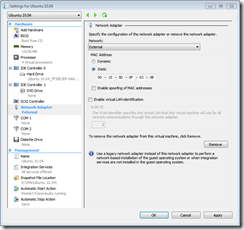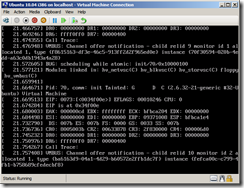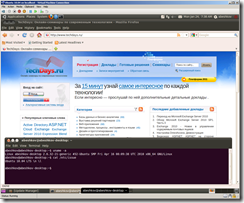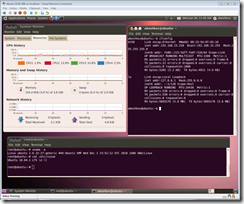Installing and Configuring Linux Ubuntu 10.04 LTS under Hyper-V on Windows Server 2008 R2
There was a bit of free time, so today I decided to write how things are going with Ubuntu 10.04 under Hyper-V.
Despite the fact that Ubuntu is not included in the list of officially supported Linux distributions, it works perfectly under Hyper-V. Moreover, no additional integration components were required. All that is needed to work with Hyper-V has long been in fresh Linux kernels.
Well, let's get started?
Take Linux Ubuntu 10.04 LTS. Both 64-bit and 32-bit versions are suitable. We create a standard virtual machine, connect the DVD with the OS and begin the installation. Please note that we leave the synthetic network interface created by default inside the virtual machine. There is no longer any need to use the legacy legacy network interface. It is recommended that you use a static Mac network interface address if this virtual machine will migrate between the physical nodes of the cluster using the Live migration mechanism. You can install in text or graphical mode. I recommend doing this using graphics, because in text mode, redrawing each menu takes 20-30 seconds. This is quite annoying, although it does not interfere with completing the installation successfully.

Immediately after starting the installation for a minute, another one can observe a heap of warning messages about a non-standard BIOS. Feel free to ignore them and continue the installation until we see the following concise message. After the first reboot, we look with lsmod for a list of loaded modules. We find that only the Hyper-V bus module called hv_vmbus is loaded. This is not enough, so we edit the file / etc / initramfs - tools / modules and add lines to it that allow the loading of the remaining modules that we need. hv_vmbus hv_storvsc hv_blkvsc hv_netvsc hv_utils


We save the file and execute the command:
$ sudo update-initramfs -u We write
in / etc / network / interfaces your new synthetic network interface seth0. If you used the legacy Legacy Network Interface, it would be called eth0.
For static addressing:
Auto seth0
iface seth0 inet static
address xxxx
netmask xxxx
Gateway xxxx
To get the address via DHCP:
Auto seth0
iface seth0 inet dhcp
I checked both network addressing methods, they work.
We reboot and in the process we see such messages that devices related to vmbus are found. After booting with lsmod, we check the loaded modules and see what network interfaces we have in the system. As you can see, the seth0 network interface is working fine. It is also worth noting that Ubuntu works fine both in a single-processor and in a multi-processor configuration. The system scales up to 4 processors without any problems. Unfortunately, the RAM resources of my test server are limited, so I could not give more than 14 GB of RAM to Ubuntu virtual machines. However, for most tasks this amount is quite enough. It is worth noting that there is no synthetic mouse support in Ubuntu, and the Satori project







has not yet been ported to this distribution, so for remote control in graphical mode, I used VNC.
Just in case, inside the virtual machines with Ubuntu, I set up a web server and an FTP server. For several days using scripts I periodically downloaded quite large amounts of data from them. Performance degradation, any problems and failures were not noticed.
The conclusion is that despite the fact that Ubuntu support is not officially announced, this distribution works under Hyper-V very reliably and, in my opinion, can be used in a production environment.
Despite the fact that Ubuntu is not included in the list of officially supported Linux distributions, it works perfectly under Hyper-V. Moreover, no additional integration components were required. All that is needed to work with Hyper-V has long been in fresh Linux kernels.
Well, let's get started?
Take Linux Ubuntu 10.04 LTS. Both 64-bit and 32-bit versions are suitable. We create a standard virtual machine, connect the DVD with the OS and begin the installation. Please note that we leave the synthetic network interface created by default inside the virtual machine. There is no longer any need to use the legacy legacy network interface. It is recommended that you use a static Mac network interface address if this virtual machine will migrate between the physical nodes of the cluster using the Live migration mechanism. You can install in text or graphical mode. I recommend doing this using graphics, because in text mode, redrawing each menu takes 20-30 seconds. This is quite annoying, although it does not interfere with completing the installation successfully.

Immediately after starting the installation for a minute, another one can observe a heap of warning messages about a non-standard BIOS. Feel free to ignore them and continue the installation until we see the following concise message. After the first reboot, we look with lsmod for a list of loaded modules. We find that only the Hyper-V bus module called hv_vmbus is loaded. This is not enough, so we edit the file / etc / initramfs - tools / modules and add lines to it that allow the loading of the remaining modules that we need. hv_vmbus hv_storvsc hv_blkvsc hv_netvsc hv_utils


We save the file and execute the command:
$ sudo update-initramfs -u We write
in / etc / network / interfaces your new synthetic network interface seth0. If you used the legacy Legacy Network Interface, it would be called eth0.
For static addressing:
Auto seth0
iface seth0 inet static
address xxxx
netmask xxxx
Gateway xxxx
To get the address via DHCP:
Auto seth0
iface seth0 inet dhcp
I checked both network addressing methods, they work.
We reboot and in the process we see such messages that devices related to vmbus are found. After booting with lsmod, we check the loaded modules and see what network interfaces we have in the system. As you can see, the seth0 network interface is working fine. It is also worth noting that Ubuntu works fine both in a single-processor and in a multi-processor configuration. The system scales up to 4 processors without any problems. Unfortunately, the RAM resources of my test server are limited, so I could not give more than 14 GB of RAM to Ubuntu virtual machines. However, for most tasks this amount is quite enough. It is worth noting that there is no synthetic mouse support in Ubuntu, and the Satori project







has not yet been ported to this distribution, so for remote control in graphical mode, I used VNC.
Just in case, inside the virtual machines with Ubuntu, I set up a web server and an FTP server. For several days using scripts I periodically downloaded quite large amounts of data from them. Performance degradation, any problems and failures were not noticed.
The conclusion is that despite the fact that Ubuntu support is not officially announced, this distribution works under Hyper-V very reliably and, in my opinion, can be used in a production environment.
